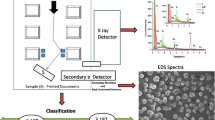Abstract
A software system Gel Analysis System for Epo (GASepo) has been developed within an international WADA project. As recent WADA criteria of rEpo positivity are based on identification of each relevant object (band) in Epo images, development of suitable methods of image segmentation and object classification were needed for the GASepo system. In the paper we address two particular problems: segmentation of disrupted bands and classification of the segmented objects into three or two classes. A novel band projection operator is based on convenient object merging measures and their discrimination analysis using specifically generated training set of segmented objects. A weighted ranks classification method is proposed, which is new in the field of image classification. It is based on ranks of the values of a specific criterial function. The weighted ranks classifiers proposed in our paper have been evaluated on real samples of segmented objects of Epo images and compared to three selected well-known classifiers: Fisher linear classifier, Support Vector Machine, and Multilayer Perceptron.
Similar content being viewed by others
References
Bajla I. and Holländer I. (2001). Nonlinear filtering of magnetic resonance tomograms by geometry-driven diffusion. Mach. Vis. Appl. 10: 243–255
Bajla I., Holländer I., Fluch S., Burg K. and Kollár M. (2005). An alternative method for electrophoretic gel image analysis in the GelMaster software. Comput. Methods Programs Biomed. 77: 209–231
Bajla I., Holländer I., Gmeiner G. and Reichel C. (2005). Quantitative analysis of images in erythropoietin doping-control. Med. Biol. Eng. Comput. 43: 403–409
Bajla, I., Holländer, I., Minichmayr, M., Gmeiner, G., Reichel, C.: GASepo—a software solution for quantitative analysis of digital images in Epo doping-control. Comput. Methods Programs Biomed. 80(3), 246–270 (2005). doi:10.1016/j.cmpb.2005.09.005
Berglund B. and Ekblom B. (1991). Effect of recombinant human erythropoietin treatment on blood pressure and some haematological parameters in healthy men. J. Intern. Med. 229: 125–130
Broffitt J., Randles R. and Hogg R. (1976). Distribution-free partial discriminant analysis. J. Am. Stat. Assoc. 71: 934–939
Chang, C.C., Lin, C.J.: Libsvm: a library for support vector machines. National Taiwan University, Taipei. http://www.csie.ntu.edu.tw/~cjlin/papers/libsvm.ps.gz (2001). Software: http://www.csie.ntu.edu.tw/~cjlin/libsvm
Görg A., Postel W. and Günther S. (1988). The current state of two-dimensional electrophoresis with immobilized pH gradients. Electrophoresis 9(9): 531–552
Häder D. (2001). Image Analysis, Methods and Applications, 2nd edn. CRC Press, Boca Raton, London, New York
Horgan G. and Glasbey C. (1995). Uses of digital image analysis in electrophoresis. Electrophoresis 16: 298–309
Hornik K., Stinchcombe M. and White H. (1989). Multilayer feedforward networks are universal approximators. Neural Netw. 2: 359–366
Hsu C.W., Chang C.C. and Lin C.J. (2001). A Practical Guide to Support Vector Classification. National Taiwan University, Taipei
Lasne F. (2001). Double-blotting: a solution to the problem of non-specific binding of secondary antibodies in immunoblotting procedures. J. Immunol. Methods 253: 125–131
Lasne F. and Ceaurriz J. (2000). Recombinant erythropoietin in urine. Nature 405: 635
Lasne F., Martin L., Crepin N. and Ceaurizz J. (2002). Detection of isoelectric profiles of erythropoietin in urine: differentiation of natural and administered recombinant hormones. Anal. Biochem. 311: 119–126
Møller M. (1993). A scaled conjugate gradient algorithm for fast supervised learning. Neural Netw. 6: 525–533
Nabney, I., Bishop, C.: Netlab toolbox (release 3). Available at http://www.ncrg.aston.ac.uk/netlab/index.php. Neural Computing Research Group, Aston University, Birmingham (2003)
Parisotto R., Wu M., Ashenden M., Emslie K., Gore C. and Howe C. (2001). Detection of recombinant human erythropoietin abuse in athletes utilizing markers of altered erythropoiesis.. Haematologica 86(2): 128–137
Ramoser, H., Biber, J., Bajla, I., Holländer, I.: Segmentation of electrophoretic images in doping-control. In: Proc. of the Intern. Conference on Mathematics and Engineering Techniques in Medicine and Biological Sciences, METMBS’04, pp. 467–470. CSREA Press, Las Vegas, USA (2004)
Randles R., Broffitt J., Ramberg J. and Hogg R. (1978). Discriminant analysis based on ranks. J. Am. Stat. Assoc. 73: 379–384
Richards P. (1998). Protein electrophoresis. In: Rapley, R. and Walker, J. (eds) Handbook of Molecular Biomethods, pp 413–462. Humana Press, Totowa, NJ
Roberts D. and Smith D. (1994). Erythropoietin: induction of synthesis to signal transduction, protein electrophoresis. J. Mol. Endocrinol. 12: 131–148
Rublík, F.: Modification of the two-sample discrimination rule of Broffitt, Randless and Hogg and its extension to the multisample case. Technical Report. Institute of Measurement Science of the Slovak Academy of Sciences, Bratislava (2006)
Stübiger, G., Marchetti, M., Reichel, C., Gmeiner, G., Allmaier, G.: Towards the identification/verification of recombinant Epo applied in doping using matrix-assisted laser desorption/ionization mass spectrometry. In: Proc. 22nd Manfred Donike Workshop on Dope Analysis 2004 (2004)
Therrien C. (1989). Decision, Estimation and Classification: An Introduction to Pattern Recognition and Related Topics, 1st edn. Wiley, New York
Vapnik V. (1998). Statistical learning theory, 1st edn. Wiley, New York
Wide L., Bengtsson C., Berglund B. and Ekblom B. (1995). Detection in blood and urine of recombinant erythropoietin administered to healthy men. Med. Sci. Sports Exerc. 27: 1569–1576
Author information
Authors and Affiliations
Corresponding author
Additional information
The results presented in the paper have been obtained within the project GASepo granted by World Anti-Doping Agency and supported by the Slovak Grant Agency for Science VEGA and by the Slovak Research and Development Agency APVV.
Rights and permissions
About this article
Cite this article
Bajla, I., Rublík, F., Arendacká, B. et al. Segmentation and supervised classification of image objects in Epo doping-control. Machine Vision and Applications 20, 243–259 (2009). https://doi.org/10.1007/s00138-007-0120-0
Received:
Revised:
Accepted:
Published:
Issue Date:
DOI: https://doi.org/10.1007/s00138-007-0120-0




